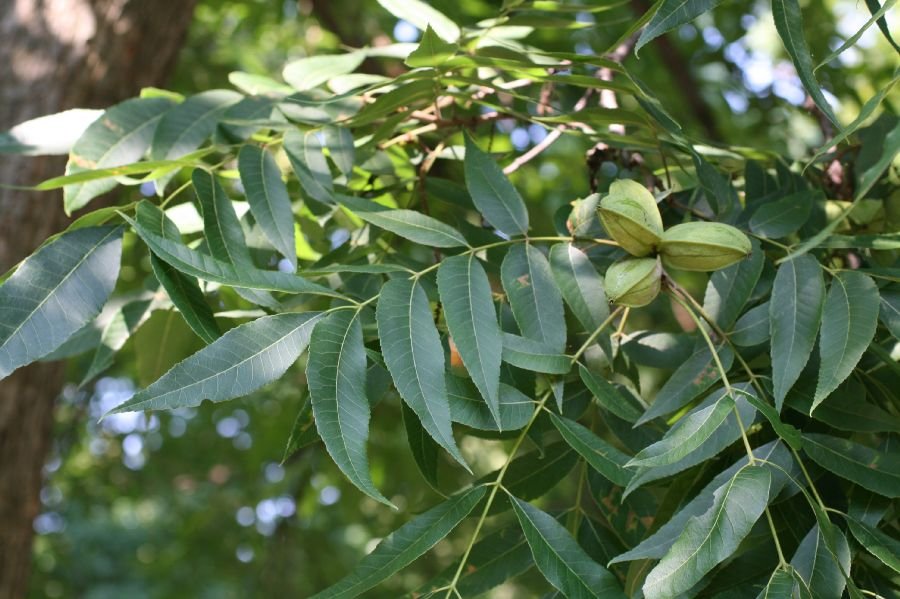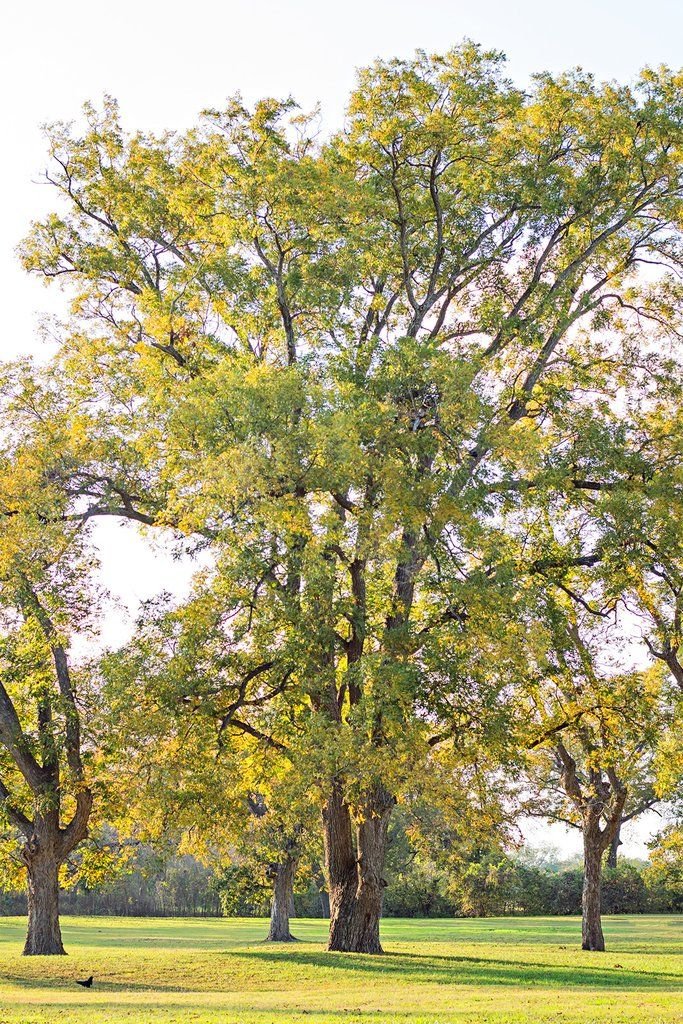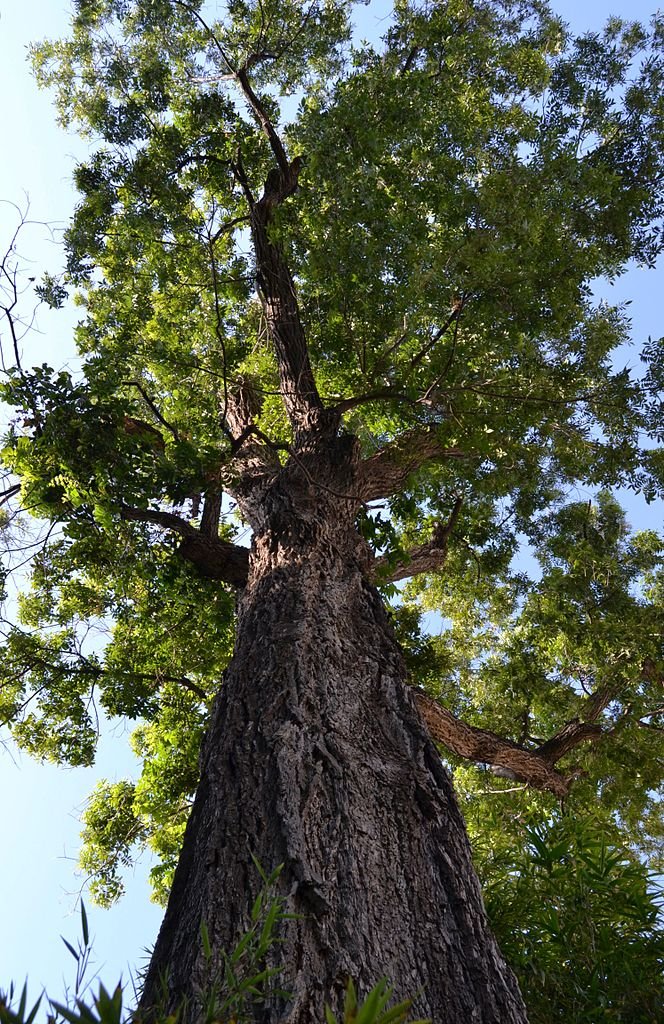Hardy Pecan
Carya illionensis. Hardy pecan is a shade tree in the Juglandaceae (walnut) family and native to the central and east central United States and Mexico. It is grown mostly for its delicious edible nuts that appear in the summer after an insignificant bloom. Grows best in full sun to partial shade. It tolerates clay, sand, and loam soils—alkaline or acidic—as long as they are well drained. It has high drought tolerance.
Pecan trees can reach up to 130 feet in height but more usually 70 to 100 feet tall with a spread of 40 to 75 feet. The largest of the hickories, this deciduous tree has a uniform, symmetrical, broadly oval crown and is massively-branched. Large major limbs grow up and out from the trunk in a distinctive upright, spreading fashion. On older trees, lower branches become wide-sweeping, with their tips almost touching the ground. Trunks can grow to 6 feet in diameter.
Pecan trees are monoecious: they have separate male and female flowers on the same tree. Pollen is not released when flowers are receptive, so pollination within and between the same cultivars is limited. These are non-grafted seedlings, not cultivars, so pollination shouldn’t be an issue if you have a few trees.
Nut production can be reduced in the northern most part of its growing range, especially when spring is late and the summer is cool. Also difficult to transplant due to a deep taproot, so choose your planting location wisely with its large mature size in mind.
Sold as bare-root seedlings in small (12” tall) and large (24” + tall).
Carya illionensis. Hardy pecan is a shade tree in the Juglandaceae (walnut) family and native to the central and east central United States and Mexico. It is grown mostly for its delicious edible nuts that appear in the summer after an insignificant bloom. Grows best in full sun to partial shade. It tolerates clay, sand, and loam soils—alkaline or acidic—as long as they are well drained. It has high drought tolerance.
Pecan trees can reach up to 130 feet in height but more usually 70 to 100 feet tall with a spread of 40 to 75 feet. The largest of the hickories, this deciduous tree has a uniform, symmetrical, broadly oval crown and is massively-branched. Large major limbs grow up and out from the trunk in a distinctive upright, spreading fashion. On older trees, lower branches become wide-sweeping, with their tips almost touching the ground. Trunks can grow to 6 feet in diameter.
Pecan trees are monoecious: they have separate male and female flowers on the same tree. Pollen is not released when flowers are receptive, so pollination within and between the same cultivars is limited. These are non-grafted seedlings, not cultivars, so pollination shouldn’t be an issue if you have a few trees.
Nut production can be reduced in the northern most part of its growing range, especially when spring is late and the summer is cool. Also difficult to transplant due to a deep taproot, so choose your planting location wisely with its large mature size in mind.
Sold as bare-root seedlings in small (12” tall) and large (24” + tall).
Carya illionensis. Hardy pecan is a shade tree in the Juglandaceae (walnut) family and native to the central and east central United States and Mexico. It is grown mostly for its delicious edible nuts that appear in the summer after an insignificant bloom. Grows best in full sun to partial shade. It tolerates clay, sand, and loam soils—alkaline or acidic—as long as they are well drained. It has high drought tolerance.
Pecan trees can reach up to 130 feet in height but more usually 70 to 100 feet tall with a spread of 40 to 75 feet. The largest of the hickories, this deciduous tree has a uniform, symmetrical, broadly oval crown and is massively-branched. Large major limbs grow up and out from the trunk in a distinctive upright, spreading fashion. On older trees, lower branches become wide-sweeping, with their tips almost touching the ground. Trunks can grow to 6 feet in diameter.
Pecan trees are monoecious: they have separate male and female flowers on the same tree. Pollen is not released when flowers are receptive, so pollination within and between the same cultivars is limited. These are non-grafted seedlings, not cultivars, so pollination shouldn’t be an issue if you have a few trees.
Nut production can be reduced in the northern most part of its growing range, especially when spring is late and the summer is cool. Also difficult to transplant due to a deep taproot, so choose your planting location wisely with its large mature size in mind.
Sold as bare-root seedlings in small (12” tall) and large (24” + tall).



